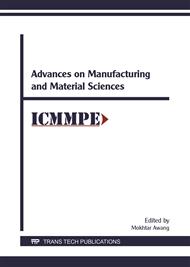[1]
S. Wang et al. Numerical simulation of acrylonitrile-butadiene-styrene material's vacuum forming process, Journal of Materials Processing Technology 91 (1999) 219–225.
DOI: 10.1016/s0924-0136(98)00440-3
Google Scholar
[2]
H. Hassan et al., 3D study of cooling system effect on the heat transfer during polymer injection molding, International Journal of Thermal Sciences 49 (2010) 161–169.
DOI: 10.1016/j.ijthermalsci.2009.07.006
Google Scholar
[3]
Smith et al. A computational model for the cooling phase of injection moulding, Journal of materials processing technology, 195(2008) 305–313.
Google Scholar
[4]
Tong Wu et al., A Framework for Optimizing the Design of Injection Molds with Conformal Cooling for Additive Manufacturing, Procedia Manufacturing, Volume 1, 2015, Pages 404–415.
DOI: 10.1016/j.promfg.2015.09.049
Google Scholar
[5]
Yun Zhang et al., A rapid BEM-based method for cooling simulation of injection molding, Engineering Analysis with Boundary Elements, 52(2015)110–119.
DOI: 10.1016/j.enganabound.2014.11.020
Google Scholar
[6]
Daver and Demirel, A simulation study of the effect of preform cooling time in injection stretch blow molding, Journal of Materials Processing Technology 212 (2012) 2400– 2405.
DOI: 10.1016/j.jmatprotec.2012.06.004
Google Scholar
[7]
A.B.M. Saifullah et al., An Investigation on Fabrication of Conformal Cooling Channel with Direct Metal Deposition for Injection Moulding, Reference Module in Materials Science and Materials Engineering, (2016).
DOI: 10.1016/b978-0-12-803581-8.04023-6
Google Scholar
[8]
Yu wang et al., Automatic design of conformal cooling circuits for rapid tooling, Computer-Aided Design 43 (2011) 1001–1010.
DOI: 10.1016/j.cad.2011.04.011
Google Scholar
[9]
Kunnayut Eiamsa-ard and Kittinat Wannissorn, Conformal bubbler cooling for molds by metal deposition process, Computer-Aided Design 69 (2015) 126–133.
DOI: 10.1016/j.cad.2015.04.004
Google Scholar
[10]
Gui-long Wang et al. Heating/cooling channels design for an automotive interior part and its evaluation in rapid heat cycle molding, Materials and Design 59 (2014) 310–322.
DOI: 10.1016/j.matdes.2014.02.047
Google Scholar
[11]
Alban Agazzi et al. Optimal cooling design in injection moulding process-A new approach based on morphological surfaces, Applied Thermal Engineering 52 (2013) 170-178.
DOI: 10.1016/j.applthermaleng.2012.11.019
Google Scholar
[12]
Bin He et al. Optimal design of longitudinal conformal cooling channels in hot stamping tools, Applied Thermal Engineering 106 (2016) 1176–1189.
DOI: 10.1016/j.applthermaleng.2016.06.113
Google Scholar
[13]
Yu Wang et al. Spiral and conformal cooling in plastic injection molding, Computer-Aided Design 63 (2015) 1–11.
DOI: 10.1016/j.cad.2014.11.012
Google Scholar
[14]
S. Sharif et al., Improving the Quality and Productivity of Molded Parts with a New Design of Conformal Cooling Channels for the Injection Molding Process, Advances in polymer technology, 21524 (2015) 1-10.
DOI: 10.1002/adv.21524
Google Scholar
[15]
Thermoforming Design Guidelines, Universal Plastics, Holyoke, (2014).
Google Scholar
[16]
Lin. Z and M. Chou, Design of the Cooling Channels in Nonrectangular Plastic Flat Injection Mold, Journal of Manufacturing Systems, 2002, 21/ 3.
DOI: 10.1016/s0278-6125(02)80160-1
Google Scholar
[17]
Salloum, Gorges. Process Modeling, in Hilton. P, Rapid Tooling: Technologies and Industrial Applications, Marcel Dekker, Inc., New York, (2000).
Google Scholar
[18]
Vinod. S, et al., Mould analysis: an enabler of agility in mould design, Int. Conf. on Computer Aided Engineering, (CAE 2007), IIT Madras, India, (2007).
Google Scholar


